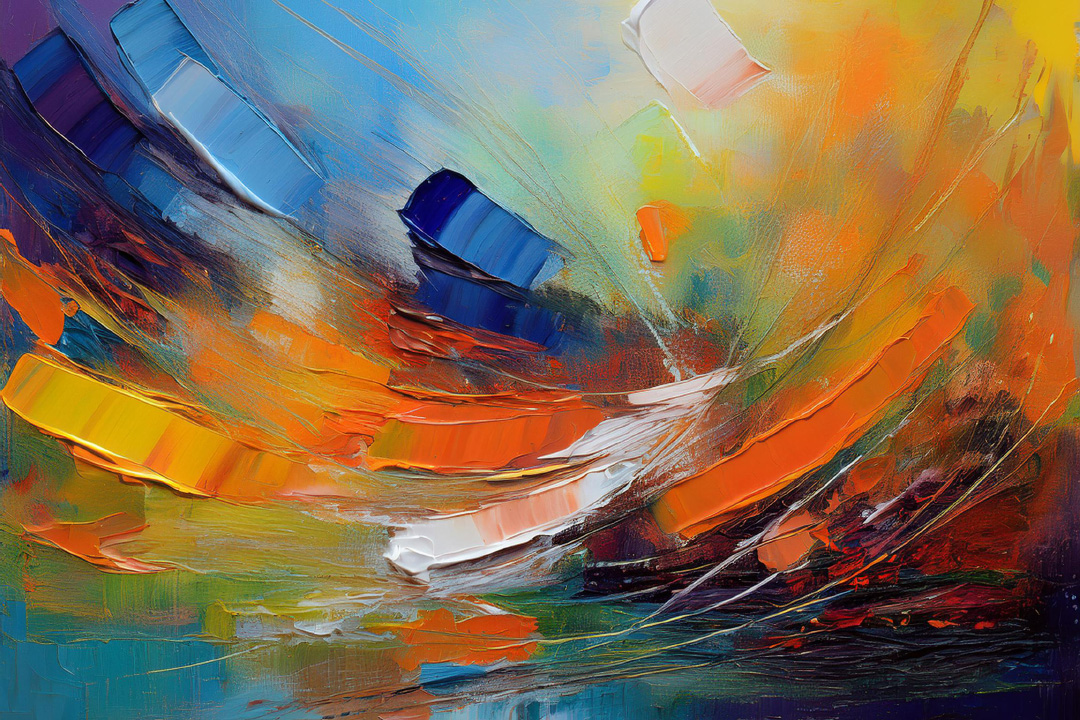Abstract art is one of the most fascinating and diverse forms of artistic expression. Unlike traditional art forms that aim to represent reality as it is, abstract art breaks away from that concept and invites both the artist and the viewer to dive into deeper emotions, interpretations, and meanings. Whether it’s the use of shapes, colors, forms, or lines, abstract art has evolved through many phases and has captured the imagination of millions.
In this comprehensive article, we will explore abstract art, its history, its significance, and what makes it so unique. Whether you’re an aspiring artist, an art lover, or someone simply curious about the world of abstract art, this article will offer insights into this creative form of expression.
What is Abstract Art?
At its core, abstract art doesn’t aim to depict reality. Instead, it focuses on using shapes, colors, and textures in non-representational ways. This means that abstract works do not necessarily attempt to reflect physical objects or scenes. Instead, they evoke emotions, ideas, or concepts that may not be easily explained through figurative imagery.
The freedom of abstract art lies in the fact that there are no strict rules or boundaries. While some artworks may hint at familiar forms, many abstract pieces are purely a reflection of the artist’s inner world, often leaving interpretation up to the viewer.
The History of Abstract Art
Abstract art, as we know it today, emerged in the late 19th and early 20th centuries. During this period, artists began moving away from the detailed depictions of the world around them. Several influential movements and artists contributed to this shift, laying the foundation for modern abstract art.
- Impressionism: Artists like Claude Monet and Edgar Degas began using looser brushstrokes and focusing more on light and color than on the clear portrayal of scenes.
- Cubism: Pablo Picasso and Georges Braque broke objects into fragmented, geometric shapes, moving further from reality.
- Expressionism: Artists like Wassily Kandinsky sought to express inner emotions and spirituality through bold colors and distorted forms.
The pioneers of these movements laid the groundwork for the more extreme abstraction that followed, particularly in the early 20th century.
Key Figures in Abstract Art
Several artists are synonymous with abstract art, each contributing in their own unique way to the evolution of the genre:
- Wassily Kandinsky: Often considered the father of abstract art, Kandinsky believed that art should not imitate nature but instead express inner feelings and ideas. His paintings are known for their vibrant use of color and abstract forms.
- Piet Mondrian: Known for his grid-based paintings, Mondrian focused on geometric shapes and primary colors. His works are often seen as a balance between simplicity and complexity.
- Jackson Pollock: Famous for his “drip paintings,” Pollock’s abstract expressionism introduced a new form of spontaneity and movement in art.
- Mark Rothko: Rothko’s large color field paintings evoke deep emotional responses, using simple forms and vast expanses of color to create a contemplative experience.
The Different Types of Abstract Art
Abstract art can be broken down into several subcategories, each with its own characteristics and focus. Below are some of the most prominent forms of abstract art:
- Geometric Abstraction: Focuses on the use of geometric shapes and forms, often emphasizing simplicity and order. Mondrian is a key figure in this movement.
- Abstract Expressionism: This style emerged in the mid-20th century, with artists like Jackson Pollock leading the way. Abstract expressionists often used large canvases and spontaneous techniques to convey emotion.
- Color Field Painting: Artists like Mark Rothko are known for this style, which emphasizes large areas of solid color to provoke an emotional response.
- Lyrical Abstraction: Combines the freedom of abstract expressionism with more fluid, emotional forms, emphasizing gesture and movement.
Why Do People Love Abstract Art?
One of the most intriguing aspects of abstract art is its open interpretation. Unlike more traditional forms of art, abstract works don’t usually have a specific “message” or meaning that the artist intends for everyone to understand. Instead, viewers are invited to engage with the piece on their own terms.
For some, abstract art provides a sense of freedom and creativity. It allows them to interpret and feel the work without any preconceived ideas or limitations. This is why abstract art can be so personal; two people might view the same painting and come away with entirely different interpretations and emotional responses.
Additionally, abstract art is often praised for its ability to evoke emotion without relying on the depiction of recognizable scenes or objects. The combination of colors, shapes, and lines can stir feelings of joy, sadness, confusion, or awe—sometimes all at once.
How to Appreciate Abstract Art
If you’re new to abstract art, you might find it challenging to fully appreciate its depth. Here are some tips to help you engage with abstract works more deeply:
- Let go of expectations: Abstract art doesn’t follow the same rules as more traditional art forms. Try to experience the piece without looking for a recognizable subject or meaning.
- Focus on your emotions: How does the artwork make you feel? Abstract art is often more about emotion than intellectual understanding, so let yourself be moved by the colors, shapes, and forms.
- Consider the artist’s intention: While the viewer’s interpretation is key in abstract art, it can also help to learn about the artist’s background and motivations. Many abstract artists aim to convey a specific emotion or concept through their work.
Abstract Art in Modern Times
Abstract art has continued to evolve and thrive in the modern era. Today, it remains one of the most influential and prominent genres in contemporary art. Many modern artists incorporate elements of abstraction into their work, blending it with other styles and techniques to create new and innovative forms of expression.
Digital abstraction, for example, is a growing field where artists use technology to create abstract works. This fusion of traditional and modern techniques has allowed abstract art to continue evolving in exciting new directions.
Famous Abstract Artworks and Where to Find Them
If you’re interested in exploring famous abstract works, there are several museums and galleries around the world where you can see these masterpieces in person:
- Museum of Modern Art (MoMA) – New York: Home to works by Kandinsky, Pollock, and Mondrian, MoMA is a must-visit for any abstract art enthusiast. Website
- Tate Modern – London: Tate Modern houses an extensive collection of abstract art, including works by Rothko and other key figures. Website
- Centre Pompidou – Paris: Known for its collection of modern and contemporary art, Centre Pompidou features works from many influential abstract artists. Website
The Future of Abstract Art
The beauty of abstract art lies in its infinite possibilities. As long as artists continue to push the boundaries of form, color, and concept, abstract art will remain a dynamic and evolving genre. With the rise of digital media and new artistic technologies, we are likely to see even more exciting innovations in the world of abstraction in the coming years.
Conclusion
Abstract art is more than just a style; it’s a philosophy of expression. It breaks away from traditional forms, encouraging both artists and viewers to explore new ways of seeing and feeling. Whether you’re drawn to the emotional depth of a Rothko painting or the spontaneous energy of Pollock’s drip art, abstract art offers something for everyone. So next time you encounter an abstract piece, take a moment to reflect on how it makes you feel—because in the world of abstraction, interpretation is limitless.
If you’re interested in diving deeper into abstract art, visit the galleries mentioned above, or explore online resources to continue your journey into this captivating world of creativity.
For art students looking to learn and research abstract art, here are some excellent websites:
- Smarthistory: This non-profit platform offers videos and essays on a wide range of art topics, including abstract art. The content is conversational and accessible, making it perfect for students who want to understand art movements, artists, and techniques in an engaging way
-
The Art Story: Focused on modern and contemporary art, this site breaks down art movements, including abstract art, into clear, easy-to-understand segments. It features artist profiles, movement summaries, and visual analysis that can help students grasp the essence of abstract art
-
Google Arts & Culture: Explore vast collections from museums worldwide, and zoom in on artworks in extraordinary detail. This platform allows you to explore different abstract artists and movements globally, helping students conduct in-depth visual research
- Tate Modern Art Terms: This site offers a comprehensive glossary of over 400 terms related to modern and abstract art. It’s an excellent resource for students to explore techniques, styles, and the language used in the art world
Tate modern art terms - Artsy: This platform not only connects collectors to art but also offers a wealth of information on artists and movements, including abstract art. The “Art Genome Project” helps users explore abstract art through various categories like subject matter and visual qualities
Artsy
These websites offer a combination of scholarly research, interactive exploration, and practical learning, making them invaluable resources for students studying abstract art.
Here some recommended links selected for you: The Best Books of the Month, Todays best Deals at Amazon, Best Sellers in Cell Phones & Accessories and last but not least the easy and great way to send a gift for the holidays: Amazon.com eGift Card (Instant Email or Text Delivery).




